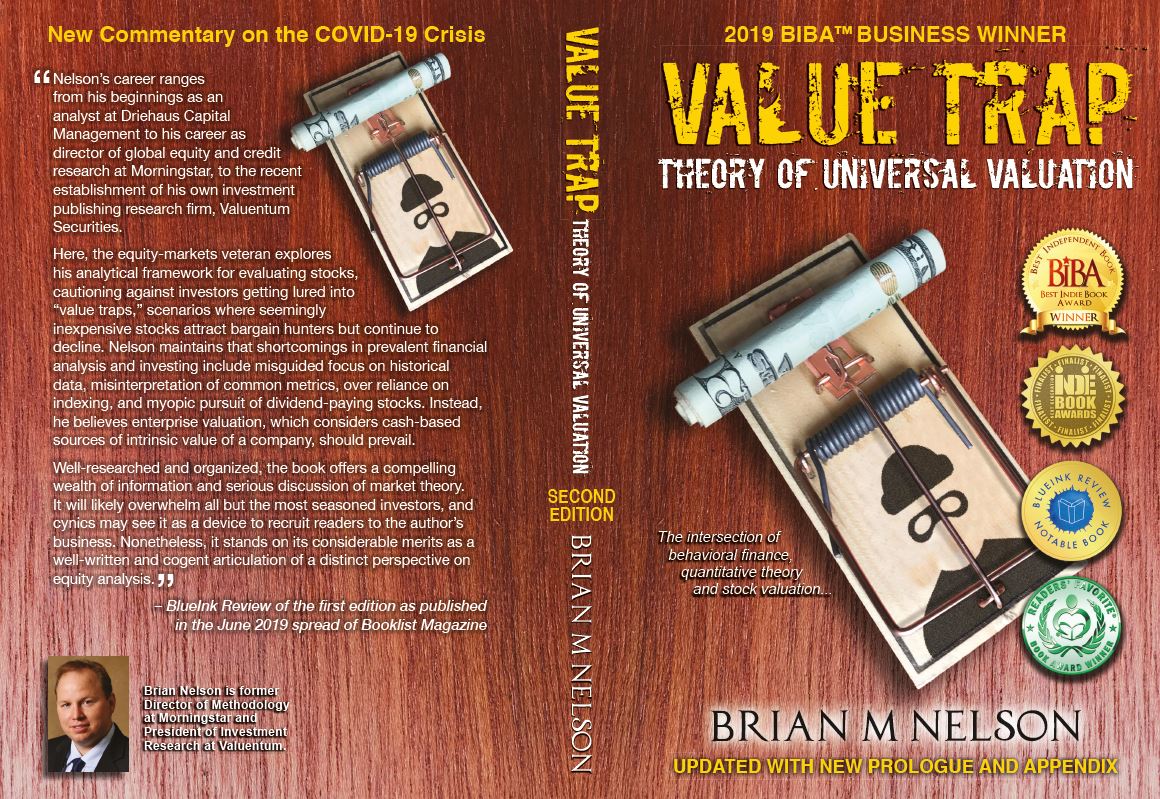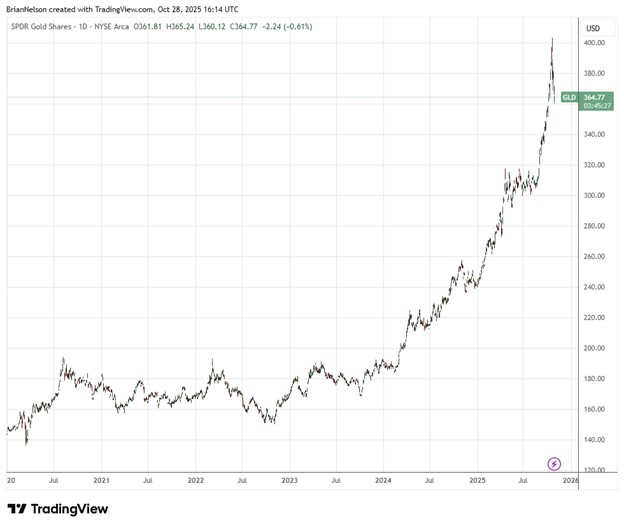Member LoginDividend CushionValue Trap |
What Is Gold Really Worth?
publication date: Oct 28, 2025
|
author/source: Brian Nelson, CFA
"What motivates most gold purchasers is their belief that the ranks of the fearful will grow. During the past decade that belief has proved correct. Beyond that, the rising price has on its own generated additional buying enthusiasm, attracting purchasers who see the rise as validating an investment thesis. As 'bandwagon' investors join any party, they create their own truth – for a while." -- Warren Buffett (2011 annual letter to shareholders)
Image: Gold prices have surged since 2020, and they recently hit an all-time high. Image Source: TradingView By Brian Nelson, CFA Stocks have quite a few variables that can affect their intrinsic value estimate, but what about gold's intrinsic value? Does gold even have value? And if so, how should we think about the value of gold (not its price, but its value)? Let's dig into these questions. Gold prices, like stock prices, are simple to derive. In a classical economics sense, there is a downward sloping demand curve and an upward sloping supply curve. You find where these two intersect, and you inevitably have a market price for the yellow metal. But while the price of gold is relatively straightforward to derive and easy to understand how it is derived, determining the real value (not price) of gold is much more difficult to do. Unlike stocks, you won’t see gold paying out cash dividends, nor does the yellow metal provide any free cash flow. That means it really doesn't make sense for us to use a dividend-discount model or a free cash flow to the firm model to derive the intrinsic worth of gold. We simply can't. Nobody can. In fact, there is no "value" calculation for gold at all. Supply and demand charts derive price, not value. Investing in gold comes down to the idea that if investors think gold can outperform other assets, it has to be driven by other investors that think the same. In other words, because speculative (investment) demand is such a large portion of the demand for gold, it really comes down to what your neighbors and friends around the world think about gold (and how their buying or selling behavior may influence it). If speculators are buying gold with the view that it is an inflation hedge, then the yellow metal might exhibit characteristics of an inflation hedge (recent research has shown that statistically, gold is not much of an inflation hedge, however, and rising inflation rates in 2022 did not send gold prices off to the races). If speculators are buying gold as a geopolitical-risk hedge (to offset what might happen to markets as a result of a potential escalation of the war in the Middle East), then the yellow metal might exhibit characteristics of a geopolitical-risk hedge. A large portion of the demand for gold is simply unpredictable -- it is not completely tied to legitimate consumer or industrial demand, and because of this, the price of gold can be quite volatile.
The "Greater Fool" Gold therefore exhibits many “greater fool” tendencies, and as a result, the market for gold has all the characteristics that are conducive to boom-and-bust dynamics (when the price of something cannot be supported by core industrial/consumer demand fundamentals but instead is substantiated by buyers that "think" there is value for one reason or another). Said differently, a lot of demand for gold may be driven by your neighbor, your taxi cab driver, or your Aunt Patsy or Uncle Paul for the sole and only investment case that they think it will go up in price and that they will be able to sell it to someone ("a greater fool") later at a higher price. They're not buying it to make jewelry or to use it for other purposes. The aggregate demand for gold has fluctuated (thanks to consumer demand and other core uses), but there’s a clear relationship between the price of gold and the tonnage allocated to speculation (investment). Potential inflation-hedge or geopolitical-risk hedge considerations aside, speculators want gold because...well...they want gold. The only reason why gold may be considered an inflation-hedge or geopolitical-risk hedge is that investors think it is -- and drive the price higher when they buy it during times when inflation or geopolitical risks are brewing, thereby making it one. There is no tangible economic connection. There's only a behavioral one. The gold market is about as fragile as it comes, and 2022 revealed that it may not be a good inflation hedge at all. Intrinsic worth? With that said, what’s the real demand for gold? If we net out jewelry, the real demand isn’t much. Real demand for gold varies, but end-uses can include electric wiring, semiconductors, cloth lining, and inclusion in vodka. However useful it is, producers tend to substitute away from gold when suitable replacements exist and are cheaper. Though the real intrinsic worth of gold is difficult to estimate, we suspect--given the large amount of investment and speculative demand--the “true” fundamental-based value of gold is considerably lower than its price is today. As Warren Buffett recently said in his 2011 annual letter to shareholders: “Today the world’s gold stock is about 170,000 metric tons. If all of this gold were melded together, it would form a cube of about 68 feet per side. (Picture it fitting comfortably within a baseball infield.) At $1,750 per ounce...its value would be about $9.6 trillion. Call this cube pile A. Let’s now create a pile B costing an equal amount. For that, we could buy all U.S. cropland (400 million acres with output of about $200 billion annually), plus 16 Exxon Mobils (the world’s most profitable company, one earning more than $40 billion annually). After these purchases, we would have about $1 trillion left over for walking-around money (no sense feeling strapped after this buying binge). Can you imagine an investor with $9.6 trillion selecting pile A over pile B?” ...A century from now the 400 million acres of farmland will have produced staggering amounts of corn, wheat, cotton, and other crops – and will continue to produce that valuable bounty, whatever the currency may be. Exxon Mobil will probably have delivered trillions of dollars in dividends to its owners and will also hold assets worth many more trillions (and, remember, you get 16 Exxons). The 170,000 tons of gold will be unchanged in size and still incapable of producing anything. You can fondle the cube, but it will not respond. Admittedly, when people a century from now are fearful, it’s likely many will still rush to gold. I’m confident, however, that the $9.6 trillion current valuation of pile A will compound over the century at a rate far inferior to that achieved by pile B." As is often the case, we agree with the Oracle of Omaha. An ounce of gold will never be more than just that -- an ounce of gold. But investors will continue to receive output from intelligent equity investments as well as from farms and oil fields. We’re not gold bulls or bears, but we have little interest in tying up a newsletter portfolio "position" directly in the yellow metal. In the words of Warren Buffett, we're simply not 'bandwagon' investors. ---------- It's Here!
The Second Edition of Value Trap! Order today!
 -----
A version of this article previously appeared on our website July 30, 2012. Brian Nelson owns shares in SPY, SCHG, QQQ, DIA, VOT, RSP, and IWM. Valuentum owns SPY, SCHG, QQQ, VOO, and DIA. Brian Nelson's household owns shares in HON, DIS, HAS, NKE, DIA, RSP, SCHG, QQQ, QQQM, and VOO. Some of the other securities written about in this article may be included in Valuentum's simulated newsletter portfolios. Contact Valuentum for more information about its editorial policies. Valuentum members have access to our 16-page stock reports, Valuentum Buying Index ratings, Dividend Cushion ratios, fair value estimates and ranges, dividend reports and more. Not a member? Subscribe today. The first 14 days are free. |



1 Comments Posted Leave a comment